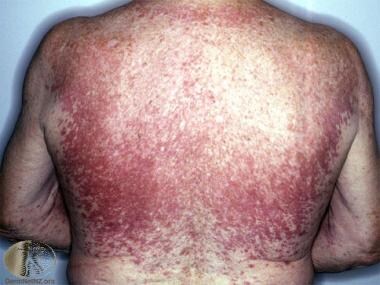Practice Essentials
A telangiectasis refers to a visibly dilated blood vessel on the skin or mucosal surface. Telangiectases that develop in the absence of any preceding or coexisting cutaneous or systemic disease are considered to be primary or essential. Telangiectases resulting from or in association with a known disease state are classified as secondary.
Different presentations of primary telangiectases have been arbitrarily classified as distinct syndromes, designated by terms that often are descriptive based on inheritance, age of onset, anatomic distribution, morphology, prognosis, or associated findings. No recognized nomenclature exists for these telangiectatic disorders. Generalized essential telangiectasia refers to one syndrome of acquired primary telangiectases that are so termed because of their widespread anatomic distribution. [1, 2] See the image below.
 Essential generalized telangiectasia. Courtesy of DermNet New Zealand (http://www.dermnetnz.org/assets/Uploads/vascular/ess-telang1.jpg).
Essential generalized telangiectasia. Courtesy of DermNet New Zealand (http://www.dermnetnz.org/assets/Uploads/vascular/ess-telang1.jpg).
Pathophysiology
The pathophysiologic factors causing blood vessel dilatation in generalized essential telangiectasia are yet to be elaborated. Familial cases have been reported with an autosomal dominant pattern of inheritance.
Signs and symptoms
The most commonly observed initial clinical presentation of generalized essential telangiectasia is telangiectasia on the feet, ankles, and distal legs. Subsequently, telangiectases appear more proximally on the lower extremities, and they also may develop on the upper extremities and trunk. In a report of 13 patients, 12 had involvement of the lower extremities. Occasionally, telangiectases first become apparent on the upper extremities or trunk. [3]
Bleeding from the ectatic vessels is rare.
Also see Physical Examination.
Complications
No physical complications are associated with generalized essential telangiectasia; however, the diffuse nature of the capillary telangiectases can be a source of emotional distress to patients. [4]
Diagnostics
Laboratory test results in generalized essential telangiectasia patients are normal.
Microscopically, capillary telangiectases consist of thin-walled ectatic vessels in the dermis, usually in the superficial portion subjacent to the epidermal-dermal junction. They are devoid of muscular, elastic, and adventitial components, and the endothelial cells are alkaline phosphatase negative, all typical features of the venous portion of the capillary loop. Ultrastructural analyses of the vessels are consistent with the telangiectases developing from the existing microvasculature—no evidence of neovascularization is apparent. [5]
These findings are in contrast to those found in the walls of normal terminal arterioles and capillary loops and the telangiectases associated with dermatomyositis, in which the endothelium is alkaline phosphatase positive. These features indicate that the telangiectases of generalized essential telangiectasia are derived from the venous portion of the capillary loop or that the anatomic construction has been altered and the biochemical activity, ie, alkaline phosphatase, has been lost as a consequence of the disease.
In 1 report, no estrogen or progesterone receptors were present in measurable levels in the single patient with generalized essential telangiectasia in whom tests were performed. Estrogen and progesterone receptors have not been found in randomly occurring telangiectases of the lower extremity.
Treatment
Treatment can be attempted with a laser that specifically targets vascular lesions, including long-pulse neodymium-doped yttrium aluminum garnet (Nd:YAG) (532 nm), long-pulse frequency-doubled Nd:YAG (1064 nm), or flashlamp-pumped pulsed dye laser (585 nm). [6, 7, 8] However, capillary telangiectases of the lower extremity, unlike those on the face, are not as responsive to photothermal coagulation with currently available vascular lasers. Multiple treatments are usually required, and, often, many of the treated capillaries remain.
Also see Medical Care.
Etiology
Etiology and pathogenesis of generalized essential telangiectasia remain unknown.
Naturally occurring substances, such as estrogen, serotonin, or adrenal corticosteroids, have no known influence on the development or progression of generalized essential telangiectasia. [9, 10]
No reported association with varicose vein disease or other superficial or underlying deep venous insufficiency has been reported.
Localized absence of telangiectases under a wristwatch has been reported. This suggests that sun exposure or mechanical factors may influence the development of telangiectases, as is observed with ataxia-telangiectasia (Louis-Bar syndrome).
A patient reported with generalized essential telangiectasia, having multiple symmetrically distributed telangiectases on upper and lower extremities, had telangiectases covering an appendectomy scar; however, other scars associated with multiple unrelated surgical procedures had none. [11]
Another study posits a connection between cutaneous collagenous vasculopathy and generalized essential telangiectasia, but the authors emphasize the importance of clinicopathological correlation in order for a diagnosis to be made. [12]
One patient exhibited symptoms that might indicate an association between generalized essential telangiectasia, corneal neovascularization, and thoracic aneurysm formation. [13]
Epidemiology
Neither the incidence nor prevalence of generalized essential telangiectasia is known.
Generalized essential telangiectasia has been reported more commonly in whites, perhaps because of the marked contrast of the vessels on light-complexioned skin.
Women are affected more commonly than are men, and in 1 published study of 13 people with generalized essential telangiectasia, 10 of the reported patients were women.
In 1 report of 13 patients, the average age of onset for generalized essential telangiectasia was 38 years. [3] The literature mentions patients as young as 11 months with the condition. [14]
Prognosis
The development of telangiectases may be gradual or rapid. Usually, telangiectases tend to progress to other sites. Lesions persist indefinitely and do not regress spontaneously. General health is not affected in patients with telangiectases. No cutaneous changes or internal diseases are associated with generalized essential telangiectasia.
-
Essential generalized telangiectasia. Courtesy of DermNet New Zealand (http://www.dermnetnz.org/assets/Uploads/vascular/ess-telang1.jpg).






